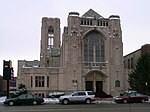Hitsville U.S.A.

"Hitsville U.S.A." is the nickname given to Motown's first headquarters and recording studio. The house (formerly a photographers' studio) is located at 2648 West Grand Boulevard in Detroit near the New Center area of the city. Motown founder Berry Gordy bought the house in 1959. Gordy converted the house to use it as the record label's administrative building and recording studio. After finding mainstream success from the mid 1960s to the mid 1970s, Gordy moved the label to Los Angeles and established the Hitsville West studio working in television and film production as well as music production. Today, the “Hitsville U.S.A” property operates as the Motown Museum, which is dedicated to the legacy of the record label, its artists, and its music. The museum occupies the original house and an adjacent former residence.
Excerpt from the Wikipedia article Hitsville U.S.A. (License: CC BY-SA 3.0, Authors, Images).Hitsville U.S.A.
West Grand Boulevard, Detroit New Center
Geographical coordinates (GPS) Address Website External links Nearby Places Show on map
Geographical coordinates (GPS)
| Latitude | Longitude |
|---|---|
| N 42.364166666667 ° | E -83.088333333333 ° |
Address
Motown Museum (Hitsville USA)
West Grand Boulevard 2648
48200 Detroit, New Center
Michigan, United States
Open on Google Maps









